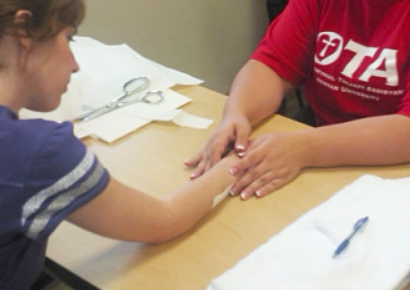Spotlight on Occupational Therapists
 Occupational therapists (OTs) form an essential part of the care teams and lives of many people with various disabilities, and are gaining increasing recognition for their accomplishments in improving quality of life. Their role comprises helping people with disabilities perform the activities of daily living and the myriad of small tasks which constitute these. Practically, This can mean taking an action, such as getting out of bed, and breaking them into a series of manageable exercises. Therapy can focus on designing and delivering an exercise regime to improve or retain function, or coming up with ideas for ways to modify environment, and helping with the process of setting up. Such help can either be ongoing through life, or a short term booster, often to people with a newly acquired disability.
Occupational therapists (OTs) form an essential part of the care teams and lives of many people with various disabilities, and are gaining increasing recognition for their accomplishments in improving quality of life. Their role comprises helping people with disabilities perform the activities of daily living and the myriad of small tasks which constitute these. Practically, This can mean taking an action, such as getting out of bed, and breaking them into a series of manageable exercises. Therapy can focus on designing and delivering an exercise regime to improve or retain function, or coming up with ideas for ways to modify environment, and helping with the process of setting up. Such help can either be ongoing through life, or a short term booster, often to people with a newly acquired disability.
OTs can help to evaluate new technologies, determining if they will be useful for a given client, and also have low tech tricks up their sleeve: a foam hair roller can make a pen usable for people with gripping issues, as with rheumatoid arthritis and RSI. They might suggest workarounds, such as grocery delivery for somebody who can't walk to the shops.

Some OTs are specialised in dealing with particular illnesses such as CFS, and, increasingly, with disabling mental illness such as bipolar disorder, anxiety and depression.
While improving client's confidence and ability is key, living environment also has a huge part to play: unsuitable housing can actively worsen a mobility limiting condition, while for a wheelchair user, a home with wide enough doors, a usable bathroom and a nice shallow ramp is a treasure. This is where Helen Donaldson comes in. Though she had an otherwise fairly normal career trajectory, with hospital-based rotational roles interspersed with periods of travel, Helen's current role is comparatively new and unusual. As a housing OT, she works with disabled people to determine their housing needs when they apply for co uncil housing. She and her colleague work within the council housing service, advising colleagues how best to meet needs of applicants and existing tenants.
uncil housing. She and her colleague work within the council housing service, advising colleagues how best to meet needs of applicants and existing tenants.
People with mobility issues (like the majority of Donaldson's clients) "have the same range of reasons for wanting to move as anyone," but their needs bring up several additional questions to answer. Once she has a handle on what a client requires, she evaluates if existing housing stock would be appropriate or can be made so, what kind of housing not to offer, which adaptations are needed. Such adjustments can be relatively easy: bathrooms can be radically improved by taking out a bath and putting in a shower, and adding grab bars, but steps and stairs are usually more challenging to work around.
Occupational therapy is not a flashy job: focusing on the quiet victory of a client who simply goes about their life without obstacles.
Like what you just read? Check out some more topics on bespoken:
Theraposture partnerships with Newlife charity and Symmetrikit prov...
Five things you don't know until you're in a wheelchair
Five things you don't know unless you're blind
Sign up to receive our weekly bulletin and join in discussions!
Tags:
Replies to This Discussion
-
Permalink Reply by Helen Donaldson on February 13, 2015 at 8:57
-
Great article, Ciorstaidh. I especially like the last bit :-)
-
Permalink Reply by Ciorstaidh MacGlone on February 13, 2015 at 11:05
-
Thats great to hear, Helen. Thanks again for chatting to me :-)
© 2025 Created by Gordon White.
Powered by
![]()
